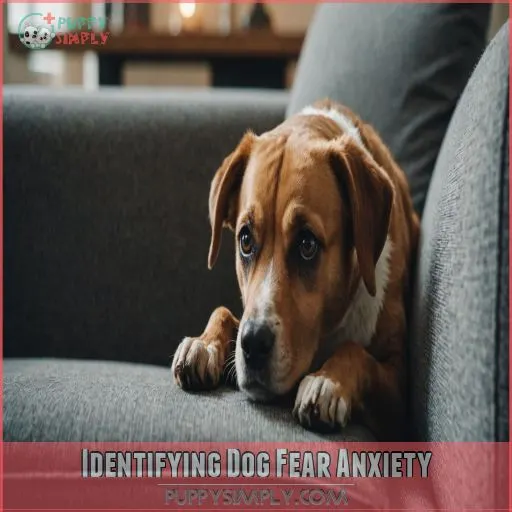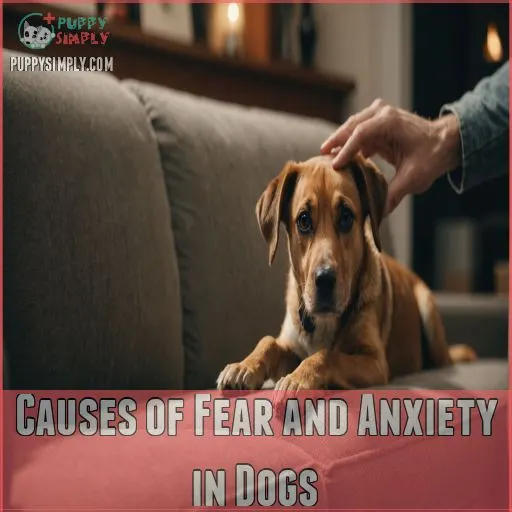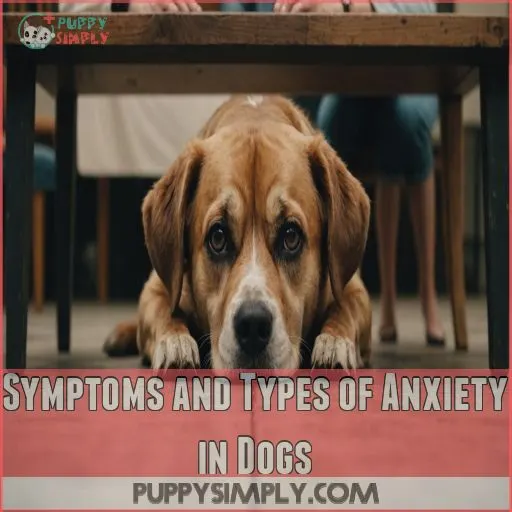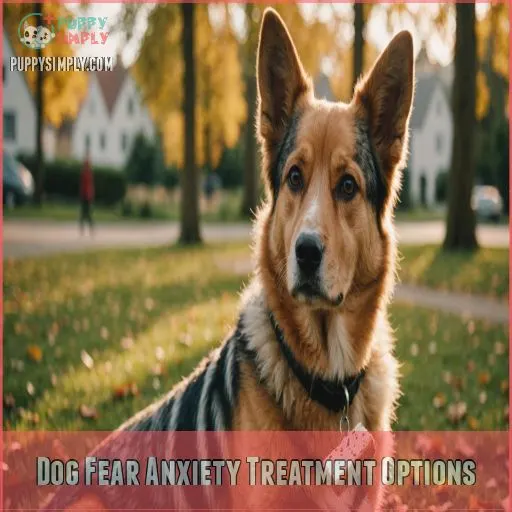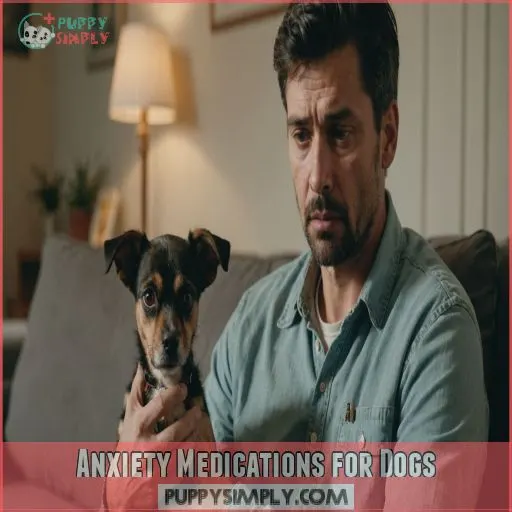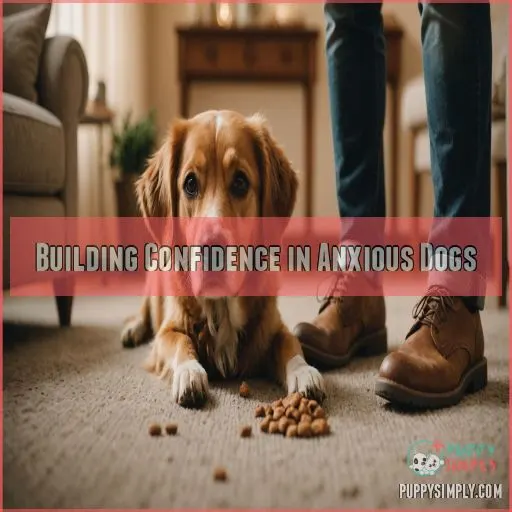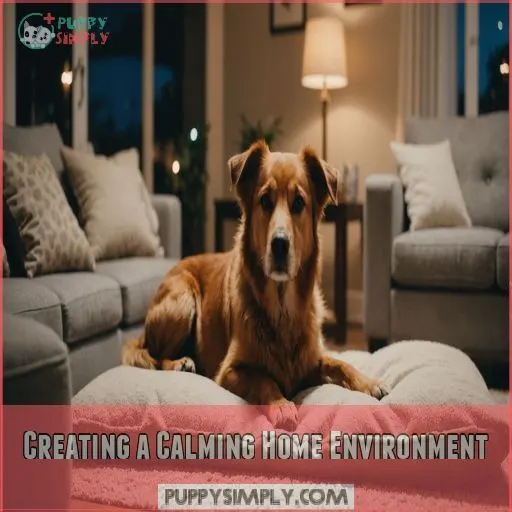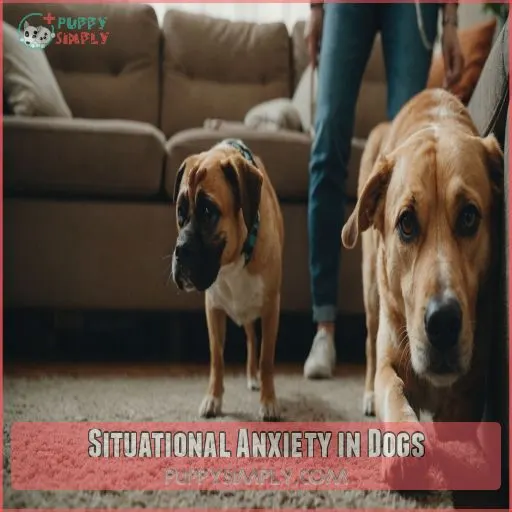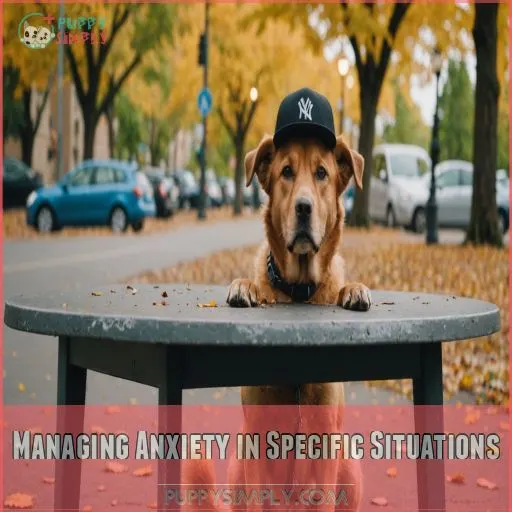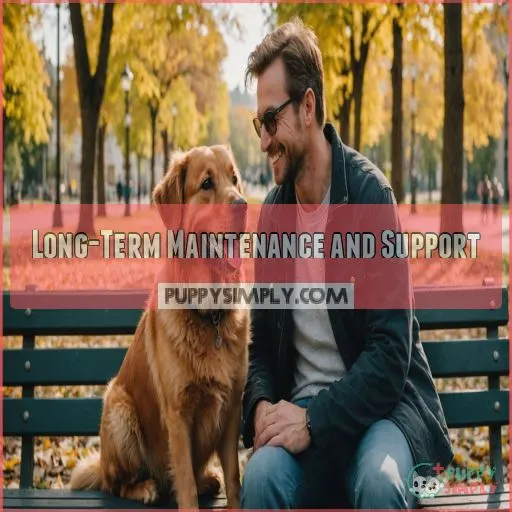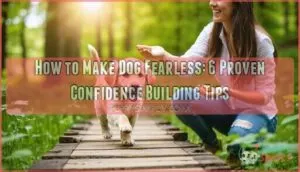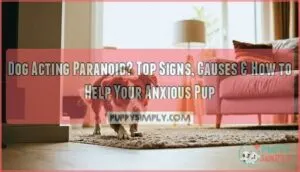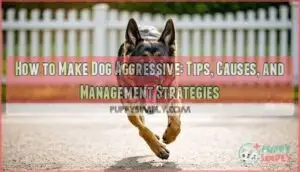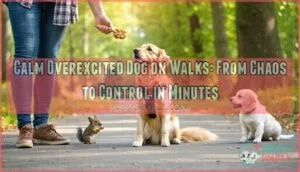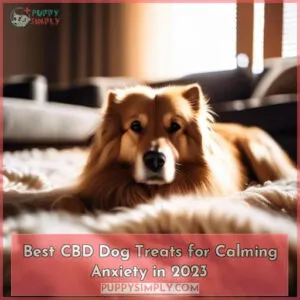This site is supported by our readers. We may earn a commission, at no cost to you, if you purchase through links.
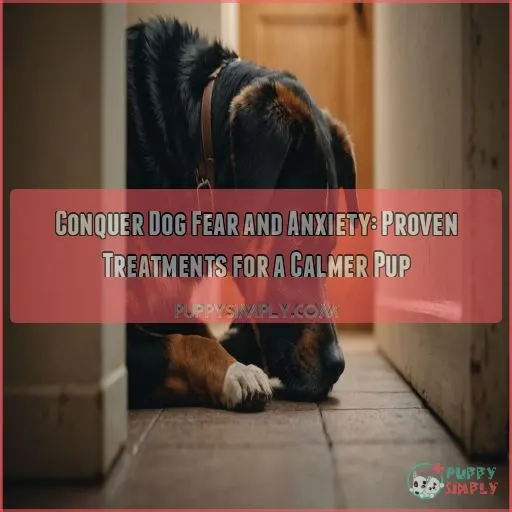 Is your pup trembling like a leaf in a storm? Don’t worry, you’re not alone in the dog fear anxiety treatment journey.
Is your pup trembling like a leaf in a storm? Don’t worry, you’re not alone in the dog fear anxiety treatment journey.
Start by identifying triggers – maybe it’s thunderstorms or the dreaded vacuum cleaner. Then, try desensitization techniques, gradually exposing your furry friend to their fears in a controlled setting.
Positive reinforcement works wonders too – treats for bravery! For severe cases, your vet might recommend anti-anxiety medications or natural remedies like CBD oil
.
Creating a calm environment with a cozy "safe space" can also help your pooch feel secure. Remember, patience is key – Rome wasn’t built in a day, and neither is a confident canine.
Stick around to uncover more tail-wagging tips for a stress-free pup!
Table Of Contents
- Key Takeaways
- Identifying Dog Fear Anxiety
- Causes of Fear and Anxiety in Dogs
- Symptoms and Types of Anxiety in Dogs
- Dog Fear Anxiety Treatment Options
- Anxiety Medications for Dogs
- Building Confidence in Anxious Dogs
- Creating a Calming Home Environment
- Situational Anxiety in Dogs
- Managing Anxiety in Specific Situations
- Long-Term Maintenance and Support
- Frequently Asked Questions (FAQs)
- What should I do if my dog is anxious?
- How do you treat anxiety in dogs?
- How do you deal with a fear of dogs?
- Can a veterinarian help a dog with anxiety?
- What is the best drug for anxiety in dogs?
- How can I calm my anxious dog down?
- Can you train anxiety out of a dog?
- Can I give my dog Benadryl® for anxiety?
- Can I give my dog melatonin for anxiety?
- How do you treat fear anxiety in dogs?
- What is the best thing for a dog with anxiety?
- Can anxiety in dogs be fixed?
- How to calm a nervous dog at home?
- How long does it take to see improvement?
- Can anxiety in dogs worsen with age?
- Are certain breeds more prone to anxiety?
- Do service dogs experience anxiety themselves?
- Can diet affect a dogs anxiety levels?
- Conclusion
Key Takeaways
- You’re not alone in this journey – anxiety in dogs is common, but with the right approach, you can help your furry friend find their inner zen. Start by identifying triggers and gradually exposing your pup to them in a controlled, positive way.
- Think of your home as a doggy spa – create a calm environment with a cozy safe space, stick to routines, and use calming aids like pheromones or music. It’s like giving your anxious pup a warm hug without the awkward arm placement.
- Don’t be afraid to call in the cavalry – your vet is your partner in fighting against anxiety. They can help rule out medical issues and may recommend treatments like behavior modification or medications. Remember, asking for help doesn’t make you a bad pet parent – it makes you a smart one.
- Patience is your superpower – Rome wasn’t built in a day, and neither is a calm, canine. Celebrate small victories, keep up with training and socialization, and remember that every anxious whimper conquered is a step towards a happier, tail-wagging life together.
Identifying Dog Fear Anxiety
Spotting fear and anxiety in your dog can feel like observing a toddler’s first day of school, with telltale signs like trembling, excessive barking, or hiding.
Understanding these early signs helps you tackle the problem head-on, putting you on the right path to a happier, more relaxed pup.
Recognizing Early Signs of Anxiety
Spotting dog anxiety early is like finding a pebble before it becomes a boulder.
Watch for these dog body language cues:
- Restlessness & pacing
- Changes in appetite
- Sleep pattern shifts
These subtle signs can speak volumes about anxiety in dogs. Don’t wait—nip it in the bud to help your furry friend find calmness and comfort.
Understanding Behavioral Issues
Ever wonder if your dog is anxious or just playing coy?
Look for clues in dog body language: trembling, tail-tucking, or avoiding eye contact.
Sometimes, anxiety triggers—like loud noises or being left alone—spark fear.
Stress management and behavioral modification, alongside vet consultations, offer essential dog anxiety treatment strategies.
Feel like a dog whisperer yet? You’re halfway there!
Common Causes of Fear and Anxiety
Understanding why your dog feels anxious or fearful can be like unraveling a mystery.
Past experiences, genetic factors, medical issues, or lack of early socialization often play a role. A sudden environmental change can be a significant factor as well.
That can be the straw that breaks the camel’s back. Identifying these triggers helps manage dog anxiety and, sometimes, separation anxiety more effectively, which is key to understanding and addressing the root cause of the dog anxiety.
Differences Between Fear and Anxiety
Now that you know what causes your dog’s nerves, let’s distinguish fear from anxiety. Fear is a direct response to a threat, while anxiety is worry about future threats. Think of fear as a sudden storm, while anxiety lingers like a grey sky.
Providing a comfortable space for your dog can also alleviate anxiety, such as using calming beds for anxious dogs like donut beds or orthopedic beds that offer a sense of security and support.
Additionally, understanding canine body language and reactions, like raised edges acting as a headrest for a relaxing nap, can also boost dog confidence and calmness.
Watch your pup’s body language and reactions; understanding these can boost dog confidence and calmness.
Causes of Fear and Anxiety in Dogs
Did you ever wonder why your dog gets anxious or fearful at the most unexpected times?
Understanding the causes, whether environmental, genetic, medical, or traumatic, can make all the difference in helping your furry friend feel safe and secure.
The text has been reorganized with the question and answer on separate lines.
Environmental Factors
Imagine your dog’s world being a symphony of noise pollution and unexpected home changes; no wonder they’re anxious!
Weather effects like thunderstorms can turn calm pups into jittery messes. Travel stress jolts routines, while familiar scents become strangers’ cologne.
To help, focus on dog desensitization and counterconditioning, as these methods foster resilience against these environmental stressors.
Genetic Predisposition
Environmental factors play a big role, but ever wonder if your dog’s fear and anxiety could be in their DNA? Some breeds just have a knack for anxiety. Think inherited traits and genetic testing.
- Breed-specific anxieties can guide treatment.
- Genetic testing offers insights into predisposition research.
- Identifying anxiety breeds helps manage dog behavior problems, like jumping when excited
.
Medical Conditions
Your dog’s anxiety might have roots in medical conditions like cognitive dysfunction or thyroid issues. These health concerns can feel like a thunderstorm on a sunny day, unexpected and unsettling.
A vet consultation is important to pinpoint underlying issues and manage physical factors. Don’t leave your dog alone in distress; make sure to prioritize their dog health and dog safety.
| Symptom | Possible Cause |
|---|---|
| Cognitive Dysfunction | Aging or neurological issues |
| Sudden Anxiety | Illness-induced anxiety |
| Aggression | Pain-related problems |
| Fear Reactions | Thyroid or hormonal imbalance |
Traumatic Experiences
A spooky ride in a thunderstorm?
Traumatic experiences can create fear triggers for your furry friend. These events might leave a lasting impact, making them jittery.
Help them recover with positive dog training and create a safe place, like a crate, offering comfort. Punishment isn’t the key; instead, focus on patience and coping mechanisms for long-term success (Source).
Symptoms and Types of Anxiety in Dogs
Does your dog panic at loud noises or seem down when left alone?
Understanding the different symptoms and types of anxiety, like separation anxiety or cognitive dysfunction syndrome, can help you figure out what’s bothering your pup.
and find ways to calm them down.
Separation Anxiety
Separation anxiety in dogs can turn a peaceful home into chaos faster than a squirrel in the yard.
Watch for signs like destructive behavior or excessive barking when left alone.
Crate training, dog-proofing your home, and gradual leave-taking cues help alleviate separation anxiety.
Consult your vet about medication options or even CBD oil for dogs as potential solutions.
Noise Phobias
Is your pup spooked by loud noises like thunderstorms or fireworks?
You’re not alone – many dogs suffer from noise phobias. Symptoms can range from mild trembling to destructive panic.
The good news? With your vet’s help, you can use proven treatments like desensitization and calming medications to ease your dog’s anxiety.
Social Anxiety
We’ve tiptoed past noise phobias and now face social anxiety. Your dog might seem anxious at the dog park, bark at strangers, or cower from new dogs during playdates.
Watch for:
- Territorial aggression
- Dog urination or defecation
- Nervous barking
Like awkwardness at a party, this social unease needs patience and understanding, possibly even professional guidance.
Cognitive Dysfunction Syndrome
Imagine your dog suddenly acting like a stranger in their own home. Cognitive Dysfunction Syndrome, akin to a dog’s version of dementia, presents challenges like disorientation and anxiety.
Symptoms can vary, and some dogs may exhibit physical symptoms such as excessive panting, shaking, and racing heart rate, while others may display behavioral changes pacing, clinginess, or destructive chewing.
As a dog owner, recognizing common stress triggers like aging, new environments, and loud noises can aid in diagnosis and management, offering treatments and support to slow progression and enhance life quality.
You’re the key to their comfort.
Dog Fear Anxiety Treatment Options
You’re not alone if your pup’s anxiety has you feeling frazzled—thankfully, there are proven treatments that can turn those paws of panic into wagging tails.
From behavioral strategies to medications, a mix of techniques can help your dog face their fears with newfound courage.
From techniques is changed to behavioral strategies
Behavioral Modification Strategies
Spotting anxiety symptoms leads us to behavioral modification strategies. These methods, like positive reinforcement and crate training, create a reliable routine.
Introduce calming signals to convey reassurance and manage anxiety triggers. Patience is key.
Picture your pup slowly gaining confidence, like finding their footing on a slippery floor. Celebrate small victories, and you’ll both feel like champions.
Desensitization and Counterconditioning
Feeling like a superhero for tackling dog anxiety? Start with desensitization and counterconditioning! By using these techniques, you’ll transform fear triggers into mere background noise.
- Gradual exposure: Increase stimuli slowly.
- Identify fear triggers: Know what spooks your pup.
- Positive reinforcement: Pair with treats and praise.
- Consistency: Stick to a plan.
Positive Reinforcement Training
After mastering desensitization, you’re ready to try positive reinforcement. Reward systems and clicker training are your best friends here. Use treats as motivators to shape behavior, turning nervous pups into confident companions.
This approach is often used in force-free positive training methods, which celebrate small wins and build confidence and motivation.
By understanding dog body language and recognizing subtle cues like tail position and ear movement, you can respond with empathy and tailor the training to address specific behavior issues related to same household aggression
.
It’s about building trust—like showing dogs that those loud mail trucks aren’t monsters but potential treat tanks! With patience, your furry friend will appreciate this approach.
Medications for Anxiety in Dogs
If your canine companion struggles with anxiety, your veterinarian may prescribe medications as part of a thorough treatment plan. These can include selective serotonin reuptake inhibitors (SSRIs) like Sertraline, benzodiazepines, and even natural alternatives like CBD oil.
Work closely with your vet to find the right solution to help your pup feel calmer and more confident.
- Sertraline (Zoloft) for separation anxiety, phobias, and compulsive behaviors
- Diazepam (Valium) for panic disorders and noise aversion
- Fluoxetine (Prozac) for separation anxiety and behavior issues
- Dexmedetomidine for immediate anxiety relief
- CBD oil for a natural, holistic approach
Anxiety Medications for Dogs
Sometimes your furry friend’s anxiety needs a little extra help.
That’s where medications can make a difference.
While options like SSRIs and CBD oil might sound a bit techy, they’ve helped many pets—and owners—find some peace.
SSRIs and Antidepressants
Struggling with your dog’s anxiety can be overwhelming, but SSRIs like fluoxetine may help.
These medications boost serotonin, often calming your pup’s nerves.
Be patient, as they can take weeks to show effects.
Watch for side effects like lethargy or appetite changes.
Always consult your vet for proper dosage and long-term use strategies.
Consider alternatives if side effects persist.
Benzodiazepines and Selegiline
Benzodiazepines and Selegiline can turn your anxious pup into a zen master. Here’s the scoop:
- Dosage guidelines are key—too high, and your dog might act like it’s had too much coffee.
- Medication side effects include sedation and increased anxiety.
- Watch for drug interactions that could lead to unwanted surprises.
Consider alternative therapies too!
CBD Oil for Dog Anxiety
CBD oil for dog anxiety can be a game changer, offering your furry friend a relaxing remedy to life’s barking mad moments.
While brands vary in quality, make sure you consult your vet for the correct CBD oil dosage.
Research shows promising results, so give it a whirl—but only with a reputable product!
Keep an eye on legality, too.
Potential Risks and Side Effects
Anxiety medications for dogs, while helpful, can sometimes be a double-edged sword.
You’ve got to watch out for long-term effects like lethargy and withdrawal symptoms.
Dose considerations are really important; too much, and you might see irregular heart rate or muscle control loss.
Always consult your vet about potential medication interactions, especially if CBD oil is involved.
Building Confidence in Anxious Dogs
Got an anxious pup?
Building their confidence isn’t rocket science—it involves teaching simple commands, social activities, fun brain games, and slowly getting them used to their triggers.
It’s like helping a shy friend feel at home at a party!
Teaching Basic Obedience Commands
Mastering basic obedience commands like Sit, Stay, Come, and Down can work wonders for an anxious pup.
These exercises build confidence by giving your dog a sense of control and predictability. Utilizing positive reinforcement techniques such as high-value treats and verbal praise can help reinforce good behavior.
By associating specific actions with specific outcomes through associative learning, you can encourage your dog to repeat desired behaviors. Start with short, positive training sessions, using treats and praise to reinforce good behavior.
With patience and consistency, you’ll see your canine companion blossom.
Encouraging Socialization
Jumpstart your dog’s confidence by scheduling early socialization, puppy classes, and trips to dog parks.
It’s like bringing a shy kid to school—a little nerve-wracking but worth it!
Invite doggie pals over for playdates or explore group walks.
Remember, Rome wasn’t built in a day. Take small steps, and you’ll see your pup blossom into a social butterfly.
Providing Mental Stimulation
Building from socialization efforts, you can boost your dog’s confidence with mental stimulation.
Try puzzle toys or interactive feeders to keep their mind sharp.
Scent games and training sessions transform challenges into fun.
Even a simple game of hide-and-seek is a winner!
These activities are entertaining and help reduce anxiety, making your pup happier and more relaxed.
Gradually Increasing Exposure to Triggers
After keeping your dog’s mind busy, tackle fearful situations with trigger management. Ease them in gradually—imagine dipping your toes into a chilly pool instead of cannonballing!
Here’s how:
- Identify the trigger: Start small; maybe it’s the mailman.
- Control exposure: Keep it brief and low-intensity.
- Reward bravery: Celebrate with treats for calm behavior.
Creating a Calming Home Environment
Creating a calming home environment for your anxious dog can do wonders for both their mood and yours.
Think of it like setting the stage for a relaxing night in—swap loud noises for soothing sounds, and soon you’ll have a happier, more relaxed pup.
Establishing a Predictable Routine
Creating a calm home for your dog starts with establishing a predictable routine. Think of it as crafting a daily dance—your pup anticipating meals, walk schedules, playtime, training sessions, and a soothing bedtime routine.
It’ll be like clockwork for them! Soon, they’ll feel more secure, and you’ll relish those peaceful, wag-filled evenings.
Dogs, just like us, thrive on certainty.
Reducing Noise and Stressors
To reduce noise and stressors, start with soundproofing your home—think of it as creating a peaceful oasis for your anxious pup.
Play white noise or calming music to drown out unpredictable sounds like thunderstorms.
Schedule quiet time with your dog, using these moments to bond and reassure them.
A relaxed pup makes for a happier household!
Creating a Safe Space for Your Dog
Your dog’s safe space should be a cozy, quiet haven where they can retreat when feeling overwhelmed, much like a doggy daycare alternative stress relief strategies
. Stock it with their favorite blankets, toys, and a supportive bed. Create barriers from noise and distractions, and make sure it’s easily accessible. This sanctuary will provide your pup with the comfort and security they crave.
- Choose a quiet, comfortable area for your dog’s safe space.
- Fill it with familiar, calming items like blankets and toys.
- Minimize outside noise and distractions to help your dog feel at ease.
Using Calming Aids and Pheromones
Imagine soothing your pup’s nerves with the magic of calming aids and pheromones. These tools, like a warm hug or relaxing music, can work wonders.
Choose from types like sprays or collars, or even try DIY calming aids at home. They’re perfect for travel or vet visits, offering peace to both pup and parent. Trust me, they work!
| Calming Aid | Ideal For |
|---|---|
| Diffuser | Home use |
| Collar | Constant comfort |
| Spray | Travel and vet visits |
| Chews | Quick anxiety relief |
| DIY Aids | Cost-effective options |
Situational Anxiety in Dogs
Does your pup turn into a bundle of nerves in certain situations?
From loud noises to unfamiliar faces, situational anxiety can turn your dog’s world upside down.
But don’t worry – there are ways to help your furry friend navigate these tricky moments, and with the right approach, you can alleviate your dog’s nerves.
Separation Anxiety Strategies
Ever felt like your pup’s giving you the cold shoulder when you leave?
Let’s tackle separation anxiety head-on! Start with gradual departures – sneak out for a minute, then slowly increase your absence.
Crate training can be a game-changer, creating a cozy den for your furry friend.
Don’t forget calming aids and anxiety medications if needed.
Remember, consistency is key – you’ve got this, pet parents!
Noise Phobia Management
Thunderstorms can turn your brave pup into a quivering mess. Noise phobias are common, affecting up to half of all dogs.
Don’t fret – you’ve got tools in your arsenal. Create a cozy ‘den’ with a blanket-covered crate to muffle scary sounds.
Play soothing tunes or white noise to mask triggers.
Remember, you’re the pack leader – stay calm and reassuring.
With patience and positive reinforcement, you’ll help your furry friend weather any storm.
Fear of Strangers and New Environments
While loud noises can rattle your pup, unfamiliar faces and places can be just as nerve-wracking. Your furry friend’s tail-tucking and trembling in new situations isn’t just being dramatic – it’s a real concern.
Let’s tackle this anxiety head-on with some tail-wagging strategies:
- Practice "stranger danger" etiquette at the dog park
- Create positive associations with treats during vet visits
- Expose your dog gradually to new environments
- Set up a safe space at home for decompressing
Travel and Car Anxiety
Some pups turn into quivering messes at the mere sight of a car. Don’t let car sickness or travel anxiety put the brakes on your adventures.
English bulldogs, in particular, may be prone to separation anxiety, which can exacerbate travel stress – understanding separation anxiety triggers is key.
Start by making short trips fun with treats and toys. Gradually increase ride duration, and consider crate training for a cozy den-on-wheels.
For stubborn cases, chat with your vet about anxiety meds. With patience, you’ll have a road trip buddy in no time!
Managing Anxiety in Specific Situations
Your dog’s world can feel scary sometimes, but you’ve got the power to help.
From fireworks freak-outs to vet visit jitters, we’ll show you how to tackle those tricky situations.
We’ll help turn your pup into a cool cucumber.
Fireworks and Thunderstorms
Your pup’s gone from cool cucumber to quivering mess. Fireworks and thunderstorms can turn even the bravest dogs into nervous wrecks.
But don’t fret! You’ve got tricks up your sleeve. Create a cozy den with background noise to muffle those scary sounds. Try calming treats or a snug anxiety vest for extra comfort like CBD treats specifically formulated for anxiety
.
Remember, staying calm yourself is key – your furry friend takes cues from you. This is because dogs can sense their owner’s emotions, which is why it’s essential to remain calm yourself and provide a comforting presence, helping your dog feel more at ease with calming treats.
Visitors and Guests
Doorbells ringing and guests arriving can turn your pup into a nervous wreck. But don’t fret! You’ve got the power to turn these anxiety triggers into positive experiences. Create a safe zone for your dog and teach them to go there when visitors arrive.
- Designate a cozy "doggy retreat" where your furry friend feels secure
- Practice calm greetings with willing friends to build confidence
- Use visitor cues to signal your dog it’s time to relax
- Reward good behavior to reinforce positive associations with guests
Vet Visits and Medical Procedures
Vet visits can turn even the bravest pups into quivering puddles of fur.
But fear not! You’ve got tricks up your sleeve to ease vet anxiety. Start with pre-visit prep: give your dog anxiety-reducing meds like gabapentin or trazodone before the visit.
During the visit, use calming techniques and positive reinforcement.
Afterward, shower your pup with love and treats. With patience and desensitization training, you’ll transform those dreaded check-ups into tail-wagging adventures!
Moving to a New Home
Moving to a new home can turn your dog’s world upside down. Just like you, your furry friend might feel a bit lost in unfamiliar surroundings.
To ease new home anxieties, try these tail-wagging strategies:
- Create a cozy "den" with familiar scents and toys
- Stick to your usual walk and feeding routines
- Gradually introduce your pup to each room, rewarding calm behavior
Remember, patience is key. Your dog’s not being stubborn – they’re just finding their paws in a new adventure!
Long-Term Maintenance and Support
You’ve helped your pup overcome their fears, but the journey’s not over yet.
Long-term maintenance is key to keeping your furry friend calm and confident.
Let’s explore how to support their progress and tackle any new challenges that pop up.
Ongoing Training and Socialization
Training your pup isn’t a one-and-done deal. It’s an ongoing journey that’ll keep your furry friend’s tail wagging.
Group classes are a great way to maintain socialization skills and build confidence. Remember, practice makes perfect!
Use positive reinforcement to keep your dog engaged and excited about learning. Try mixing up your training routine with new experiences – it’s like hitting the gym for your dog’s brain.
Keep it fun, and you’ll both reap the rewards!
Regular Veterinary Check-Ups
Regular check-ups are your pup’s ticket to a worry-free life.
Think of them as your dog’s spa days – they’ll catch any underlying conditions early, saving you both from future stress (Source).
Your vet’s expert eyes can spot subtle changes you might miss, ensuring preventative care is on point.
They’ll review medications, monitor behavior, and keep your furry friend’s tail wagging.
It’s like giving your pup a superhero cape against anxiety, securing them a life of worry-free bliss.
Adapting to Changes and Transitions
Life throws curveballs, but your pup can roll with the punches.
Ease into changes gradually, like a new family member or moving house. Create a familiar corner with your dog’s favorite toys to provide a sense of security.
When traveling, pack comfort items to reduce anxiety (Source).
Remember, your furry friend takes cues from you – stay calm and positive. With patience and love, you’ll both adapt to new adventures together. You will navigate new adventures with your furry friend.
Building a Support Network for You and Your Dog
Every dog owner needs a pack of their own.
Seek out dog trainer referrals from your vet for expert guidance.
Join online communities and local groups to share experiences and tips. You’re not alone in this journey.
Support groups can be a lifeline when the going gets ruff.
Remember, even the most anxious pups can become calm companions with the right network backing you up.
Frequently Asked Questions (FAQs)
What should I do if my dog is anxious?
Spotting signs of anxiety in your pup?
Don’t panic! Create a safe space, stick to routines, and consider exercise to blow off steam.
If it’s chronic, consult your vet about behavior modification or medication options.
How do you treat anxiety in dogs?
Did you know 14% of dogs suffer from separation anxiety?
To treat your pup’s worries, start with vet-recommended behavior modification. Combine this with exercise, a safe space, and possibly medication.
It’s like giving your furry friend a anxiety-busting toolkit!
How do you deal with a fear of dogs?
Facing your fear of dogs starts with understanding its roots.
Gradually expose yourself to canine encounters, learn dog body language, and practice relaxation techniques.
If needed, seek professional help for cognitive behavioral therapy to overcome your cynophobia.
Can a veterinarian help a dog with anxiety?
Your vet’s your partner in tackling your dog’s anxiety.
They’ll rule out medical issues, then create a personalized plan.
It might include behavior modification, training, or even medication to help your furry friend feel more at ease.
What is the best drug for anxiety in dogs?
The best anxiety medication for dogs varies based on their specific needs.
Your vet might recommend SSRIs like sertraline for long-term treatment, or fast-acting options like dexmedetomidine for acute episodes.
Remember, meds work best alongside behavior modification techniques.
How can I calm my anxious dog down?
You’ve got this! Exercise your pup to burn off anxious energy.
Try a calming massage or cuddle session. Use music or white noise to soothe.
For persistent anxiety, consider a Thundershirt or natural supplements.
Can you train anxiety out of a dog?
Training can help manage dog anxiety, but it’s not a quick fix.
Use positive reinforcement, desensitization, and counterconditioning techniques. Be patient and consistent.
For severe cases, consult a vet about combining training with medication for best results.
Can I give my dog Benadryl® for anxiety?
Barking up the wrong tree with Benadryl for anxiety?
While it might make your pup drowsy, it’s not a magic pill for fear.
Talk to your vet about better options like anxiety vests, pheromones, or prescription meds.
Can I give my dog melatonin for anxiety?
Melatonin can help ease your dog’s anxiety.
It’s safe when used correctly and may reduce stress during fireworks or storms.
Talk to your vet about the right dose based on your pup’s size and needs.
How do you treat fear anxiety in dogs?
Addressing fear anxiety in dogs requires patience and understanding.
Start with positive reinforcement and gradual exposure to triggers.
Consider daily anti-anxiety medications for severe cases.
Create a safe space and consult a veterinary behaviorist for personalized strategies.
You’ve got this, pup parent!
What is the best thing for a dog with anxiety?
You’ve got options to soothe your furry friend’s nerves.
Try creating a safe space, increasing exercise, or using pheromone diffusers.
For severe cases, your vet might recommend behavior training or medications.
Remember, patience is key in helping your pup relax.
Can anxiety in dogs be fixed?
Hope isn’t lost for your anxious pup!
While some cases can be fully cured, others are managed effectively.
Exercise, physical contact, and massage can work wonders.
Professional help and medication may be necessary for severe cases.
How to calm a nervous dog at home?
Feeling like your pup’s nerves are on a tightrope? Exercise is your best friend.
Take them for a walk, play fetch, or try puzzle toys.
Physical contact and massage can work wonders too.
Create a calm environment with soothing music.
How long does it take to see improvement?
Improvement varies, but consistency is key.
Stick to your training routine for at least a few weeks.
Some dogs show progress in days, others months.
Remember, it’s a journey – celebrate small wins along the way!
Can anxiety in dogs worsen with age?
Your dog’s anxiety can indeed intensify with age.
Physical changes, cognitive decline, and sensory loss can amplify stress.
You’ll notice shifts in behavior, like increased clinginess or restlessness.
Don’t fret – there are ways to help your furry friend cope with physical changes.
Are certain breeds more prone to anxiety?
Every dog has its day, but some breeds are more prone to anxiety.
Havanese, Pembroke Welsh Corgis, and medium-sized herding breeds top the list of anxious breeds
.
Labradors, Rottweilers, and German Shepherds tend to be more laid-back .
Do service dogs experience anxiety themselves?
Service dogs can indeed experience anxiety, just like any other dog.
Their training helps them manage stress, but they’re not immune.
Regular breaks, proper care, and recognizing their emotional needs are essential for keeping these hardworking pups balanced and happy, especially in providing them with regular breaks.
Can diet affect a dogs anxiety levels?
Like a tightrope walker, a dog’s diet balances their mental state.
You’ll find that nutrition impacts anxiety levels considerably. A well-balanced diet rich in proteins, complex carbs, and essential nutrients can help soothe your pup’s nerves.
A well-balanced diet rich in proteins, complex carbs, and essential nutrients is essentially a well-balanced diet that can help soothe your pup’s nerves.
Conclusion
Remember, Rome wasn’t built in a day, and neither is a calm, confident pup.
Tackling dog fear and anxiety is a journey that requires patience, consistency, and love. By understanding your furry friend’s triggers and implementing proven dog fear anxiety treatments, you’re paving the way for a happier, more relaxed companion.
Whether it’s through behavioral training, medication, or creating a zen-like home environment, there’s a solution out there for every anxious pooch.
Keep at it, and soon you’ll both be enjoying a more peaceful, tail-wagging life together.

